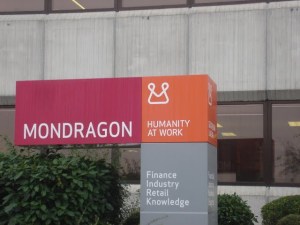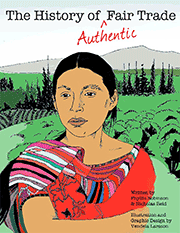The following article was written by Aaron Dawson, Equal Exchange Customer Service Manager and former Worker-Owner Coordinator.
It seems somewhat ironic that exactly a week after I return from my St. Mary’s Master of Management – Cooperatives and Credit Unions study tour of Mondragon, Spain, where the world’s largest formalized network of worker co-ops lives, the United Steelworkers announced their collaboration with Mondragon to develop and grow manufacturing worker co-ops in the U.S. & Canada (click here to visit that announcement from the United Steelworkers Union). Had I known this announcement was coming, maybe I could have just waited a couple years and visited a Mondragon co-op somewhere in the U.S.
But let’s back up a little and ask: Why is the fact that some Spanish company is opening manufacturing plants here in the U.S. so exciting? Well, for one, we could certainly use more manufacturing jobs, but that’s just the beginning. Mondragon is exciting because it is such a large and complex network of worker-owned businesses, ranging from worker-owned auto parts manufacturing plants, worker-owned kitchen appliance manufacturing plants, worker-owned and consumer-owned grocery stores, worker-owned credit unions and even a worker-owned University where professors and university workers own the University.
What is also amazing about Mondragon is its history. The worker co-ops were started by a young priest, Don Jose Maria Arizmendiarrieta, who came to Mondragon in 1941. At that time, Mondragon was one of the most economically depressed areas in the Basque region of Spain. Soon after his arrival, he organized the community to help fund a democratically structured Polytechnic school to teach young people both the skills they needed to get work, as well as teaching them the overall dignity of their labor. Shortly after the opening of the school, a few of his early graduates found that working in a traditionally structured company was not enough. They wanted to work in a company that placed value on their labor above all else, empowered workers to not only share in the profits of the company they worked for, but also share in the decision making as well. Thus, five of the early graduates, with Don Jose Maria’s guidance and again, the financial help of community members, purchased a small factory, hired worker-owners and started manufacturing and selling small ovens. Soon after, again with the guidance of Don Jose Maria, a credit union was formed to help fuel the rest of Mondragon’s growth.
From these humble beginnings, we now have a co-operative network that has a total of $49.5 billion, with over 70,000 worker-owners and 92.3% of the share capital coming from those same worker-owners. Along with the types of organizations listed above, they also have a worker-owned insurance co-op, research and design co-ops and worker-owned distribution co-ops. On top of this, every co-op in Mondragon invests 10% of their profits toward the research and design for new products and services. Two percent of each co-op’s profits goes towards a solidarity fund for individual co-ops who may be struggling and need assistance. When looking at Mondragon 50 years later, we can see not only a powerful co-operative network, but also an area that, through Don Jose Maria’s guidance, went from one of the most economically depressed areas in the Basque region to one the biggest employers in the Basque Region. In the end, one could say that Don Jose Maria Arizmendiarrieta accomplished what most community developers can only imagine in their wildest dreams, all through the vehicle of worker–owned co-ops!
So, when the United Steelworkers Union announced that they would be collaborating with Mondragon to create worker-owned manufacturing jobs in the U.S. and Canada, it is an understatement to say that this is very exciting news for the Worker-Owned Co-operative movement in the North America. My own excitement was furthered when I heard that one of the people in attendance (via phone) for that announcement was the head of Mondragon’s America’s Division, Fernando De Landa – Director of International Operations (America), who had spoken to our group just the week before in Mondragon. And although when we met with him, he did not announce this partnership, he did talk a bit about what Mondragon looks for when going into partnership with organizations overseas: organizations that not only are familiar with the local area and the market, but also organizations that match their values. He likened this type of relationship to a marriage, where the matching of values is as important to anything else in making a successful collaboration.
In my opinion, not only will Mondragon’s decision to collaborate with the United Steelworkers result in good bit of splash, it will also result in a terrific marriage. Mondragon will be working with an organization that has been fighting since 1942 for the right of workers to have such things as collective bargaining, higher wages and paid vacations, and believes that the true value of a product comes from the labor that goes into it. These beliefs are shared by Mondragon, whose new corporate name is, Mondragon: Humanity at Work, and has been striving to empower the worker-owners in its own organization for over fifty years.
The collaboration of these two organizations is a monumental move for both the U.S./Canada labor movements and the U.S./Canada worker co-op movements. Although no specific plans have been laid out as of yet, it is definitely a step in the right direction. Unions will have a chance to innovate the working world once again by actively working with and encouraging a worker-owned model. This partnership will also help shine new light on the successes and benefits of Mondragon and the benefits of the worker co-op model as the labor union movement continues to look for new ways to advance the working conditions and the empowerment of workers in the U.S. and Canada.
As for my trip to Mondragon, please check out the blog next week for part 2: Mondragon today!






This is wonderful news and I am excited to be reading your blog.
PPM
When I learned about “syndicalism” in community college years ago it struck me as a way to strike a balance between the (theoretical) efficiencies of that mythical beast — the “free market economy” — that could also give workers a stake in the system. The global economic crisis reminded me of Arizmendiarrieta so I wrote a song about him: http://on.fb.me/fmCnRb … hope I’m not mangling his name too badly